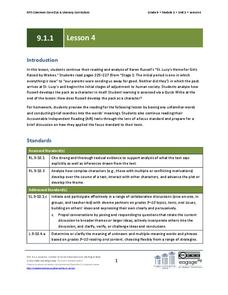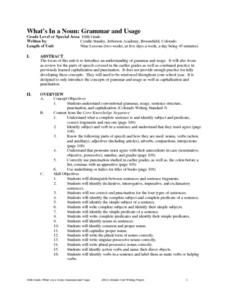Curated OER
To Quote or Not to Quote
Introduce your middle and high schoolers to the correct use of quotation marks. They identify examples of correct and incorrect quotations in magazines and edit a paragraph in groups. Use this lesson as a way to reinforce proofreading...
Curated OER
Punctuation 2: Other than Commas
Thoroughly cover the nuances of apostrophes, quotation marks, dashes, hyphens, colons, and semi-colons. Intended for higher-level English classes, the examples given pertain to tricky rules and formal language. There are no animations or...
Curated OER
Language Arts: Quotation Marks Practice
After reviewing the eight rules for using quotation marks, class members complete worksheets as independent practice and review how these punctuation marks change the meaning of a sentence. Additional worksheets are provided for homework.
Curated OER
Unnatural Selection
Young scholars identify quotation marks and demonstrate the uses of quotation marks. They rewrite sentences without quotation marks and discuss how the meanings can change without the use of quotation marks. In addition, they make their...
Curated OER
What Did You Say?
In this quotation worksheet, students read the punctuation rules for the use of quotation marks and commas in a direct quote. They insert the quotation marks in 5 sentences, and place the comma and quotation marks in 5 more.
Curated OER
Punctuating Direct Speech
Have your class practice their punctuation by studying direct speech. A rather convoluted but fun way to explain speech marks is explained, using sheep, and punctuation marks to represent their pen. Your class will see how each word is...
EngageNY
Analyzing the Central Ideas, Part 1: “The Border”
What is your strategy? Scholars read "The Border" and work with a partner to practice reading strategies to use while independent reading. They identify difficult parts where they practiced rereading by marking them with sticky notes,...
Curated OER
Mark Twain Lesson Plans
Celebrate the birthday of Mark Twain and learn about American life and literature along the great Mississippi River.
K12 Reader
Punctuation Theater
Break out the slide whistles, triangles, and tambourines. It's time for a punctuation lesson. This richly detailed plan is loaded with ideas and activities for using rhythm instruments to accent the punctuation in folk tales. A great way...
EngageNY
Reflecting on Douglass’s Narrative
The conclusion of Narrative of the Life of Frederick Douglass comes to life in a reader's theater. The class discusses the use of quotation marks in the text and then divides parts among the groups. After the performances, groups...
Curated OER
Who Said It?
In this quotation marks worksheet, young scholars practice using quotation marks and commas by selecting a sentence from the sentence bank to complete each blank.
Curated OER
Quotations and Capitals
Students read a story in which they identify the instances of dialogue. As a class, they determine how to tell someone is talking in their reading and use different sentences to identify where the quotations marks should be placed. To...
Curated OER
What is Plagiarism?
A little redundant, this quiz nonetheless drives the point home: don't plagiarize! Nearly all questions are hypothetical scenarios followed by "Is this plagiarism?" Reinforce this notion through a quick quiz online.
EngageNY
Grade 9 ELA Module 1, Unit 1, Lesson 4
Connect with the text using helpful annotation strategies. As your class reads the first section of Karen Russell's short story, "St. Lucy's Home for Girls Raised by Wolves," they note important passages that establish character...
Curated OER
Using Quotes as "Thought Shots"
Students explore how to use quotation marks in writing to add dialogue to a paper. In groups, students observe pictures and add quotations to them. Students follow rules of punctuation and capitalization as they proofread and edit each...
Curated OER
Those Baffling Bibliographies!
Are you working on a research and citation unit? Have your young writers listen to a lecture on how to cite research sources correctly and how to distinguish new information that requires citing. They compile a list of works cited from...
Curated OER
What's In a Noun: Grammar and Usage
Nine lessons in a grammar and usage unit provide endless opportunities for drill and practice. Topics include the four types of sentences, subject and predicates, nouns, verbs, adjectives, pronouns, adverbs and prepositions, conjunctions...
Curated OER
Presidents: Bibliography
Give credit where credit is due! After listening to a lecture/demo about why creating a bibliography is important, what should be included in a bibliography, and how to craft a bibliography, class members draft one for their own research.
Curated OER
Pasta Punctuation
Fourth graders put elbow macaroni where commas and quotation marks are supposed to be in sentences. In this punctuation lesson plan, 4th graders use the pasta to define where punctuation is missing in sentence strips.
Curated OER
Transparency
Eighth graders discover proper use of quotation marks. They examine conversations between characters in comics and magazines. In pairs, 8th graders punctuate sentences correctly. They create a story, with dialogue, involving people in a...
Pearson
The Adventures of Huckleberry Finn Activity Worksheets
Designed to accompany a reading of The Adventures of Huckleberry Finn, this packet includes before, during, and after reading activities. Individuals respond to questions about events in the story, match characters with quotes, and draft...
Curated OER
Speech Marks
Students will read through a transcript. They then brainstorm words that demonstrate that people are talking. Students then rewrite the transcript report as a description of the actual conversation.
Curated OER
Wild Swans Reader's Guide
While reading Wild Swans by Jung Chang, guide your scholars with these questions. Twenty-nine questions challenge their comprehension, which they use to create a double-entry journal for marking down important quotes and their relevance...
Curated OER
Quotations
For this reading worksheet, students think about the meaning of famous quotations. Students read 5 quotations and four possible meaning choices. Students select the correct meaning that fits each quotation.

























